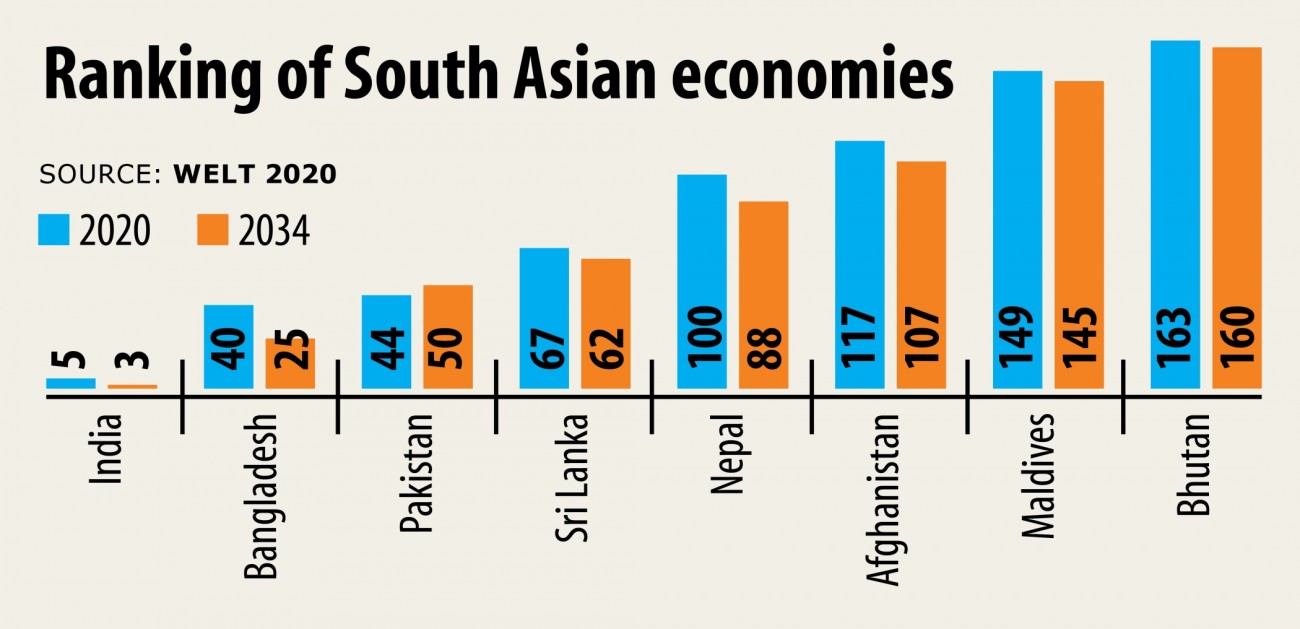Bangladesh economy to be 25th largest in 15 years

Bangladesh’s economy will make one of the biggest jumps between 2020 and 2034 on the back of demographic dividend and rising per capita income, according to the World Economic League Table 2020.
Bangladesh ranks 40th among 193 countries this year and will rise to 25th in 2034, a spot currently held by Belgium, showed the latest edition of the WELT, produced by London-based Centre for Economics and Business Research (CEBR), an international economic forecaster.
In the long run, the report said, many Asian economies will rise through the ranks of the WELT as these countries cash in on their demographic dividends.
The two most prominent examples are the Philippines, which will enter the top 25 largest economies reaching 22nd place in 2034, and Bangladesh, it said.
With a purchasing power parity adjusted GDP per capita of $5,028 in 2019, Bangladesh is a lower middle-income country. The economy performed well in 2019, expanding by an impressive 7.8 percent. This is, however, below the 7.9 percent GDP growth rate recorded in 2018.
In Bangladesh, the population has risen at a rate of just 1 percent per year since 2014. This has meant that per capita incomes have grown considerably in recent years.
Government debt as a share of GDP rose to 34.6 percent last year, up from 34 percent in 2018. Despite the increase, the public sector finances remain in good shape. The relatively low debt burden has provided the government with the fiscal headroom to operate a budget deficit of 4.8 percent in 2019.
The annual rate of GDP growth is forecast to slow to an average of 7.3 percent between 2020 and 2025.
Over the subsequent nine years, the CEBR forecasts that the economy will remain at this impressive rate, which will see Bangladesh climb from 40th place in the WELT to 25th place by 2034.
Three rapidly growing Asian economies are the fastest risers in the table amongst the larger economies: the Philippines, Bangladesh, and Malaysia.
In South Asia, India has decisively overtaken both France and the UK to become the world’s fifth largest economy in 2019. It is expected to overtake Germany to become fourth largest in 2026 and Japan to become the third largest in 2034.
Pakistan is forecast to move from 44th place to 50th place between 2020 and 2034. The Maldives will also fall from 149th to 145th.
Nepal will rise from 100th to 88th place in 2034, Sri Lanka from 67th to 62nd, Bhutan from 163rd to 160th, and Afghanistan from 117th to 107th.
The US is now expected to remain the world’s largest economy throughout the 2020s and is to be overtaken by China only in 2033, CEBR’s 11th annual world economic outlook report said.
The WELT tracks the size of different economies and projects changes over the next 15 years, up to 2034. The base data for 2019 is taken from the International Monetary Fund’s World Economic Outlook and the GDP forecast draws on CEBR’s Global Prospects model to forecast growth, inflation and exchange rates.
The report said 2019 was a bad year for the world economy with the weakest GDP growth since the recession year of 2009. But the clouds started to lift towards the end of the year and the CEBR predicts that expansionary fiscal and monetary policy around the world will cause growth to accelerate in 2020.
In 2019, any lingering “feel-good factor” from the upswing of the global economy in 2017 largely dispersed and was replaced by renewed volatility and uncertainty. Trade tensions came to the fore with the US and China imposing substantial tariffs on each other’s export sectors.
Perhaps the most unexpected element in this report is the ongoing strength of the US economy, though the CEBR expects that 2019 will prove the high water mark as the problems of the trade war and the deficit impinge. But in 2011, the US economy was 21.2 percent of world GDP. In 2019 its share had risen to 24.8 percent, its highest share since 2007.
“The biggest surprise is how well the US economy has managed to do, reaching its highest share of world GDP for 12 years,” CEBR Deputy Chairman Douglas McWilliams said in a statement.
“Though our view is that it has reached its high water mark and moving forward the deficit and its trade disputes will start to hold it back. Still, this is a remarkable performance for an old world economy. ”
“The battle for the top spots in the WELT league table remains fiercely contested,” Kay Daniel Neufeld, head of macroeconomics at the CEBR, said.
Despite the rapid ascent of countries such as India and Indonesia, it is striking how little an impact this will have on the US and China’s dominant roles in the global economy, Pablo Shah, senior economist at the Cebr, said.
“Indeed, their share of world GDP is forecast to rise to 42 percent by 2034. The 2020s are set to be a decade marked by continued tensions between the US and China on multiple fronts ranging from trade to tech, which will cast a long shadow over the rest of the global economy.”
According to the CEBR, the world in 2033 is likely to be very different from that in 2019. The emerging economies will have largely emerged; the biggest element of trade will be down phone lines; and many aspects of the physical trade between Asia and Europe will be transported by land rather than by sea.
“Technology will transform business and we run the risk that income inequality will be much higher than it is now. The environmental challenge will remain and one of the key determinants of growth will be how well we deal with this.”
“The key to making the next 15 years successful and prosperous for as many as possible will be how we as a society cope with these challenges.”
